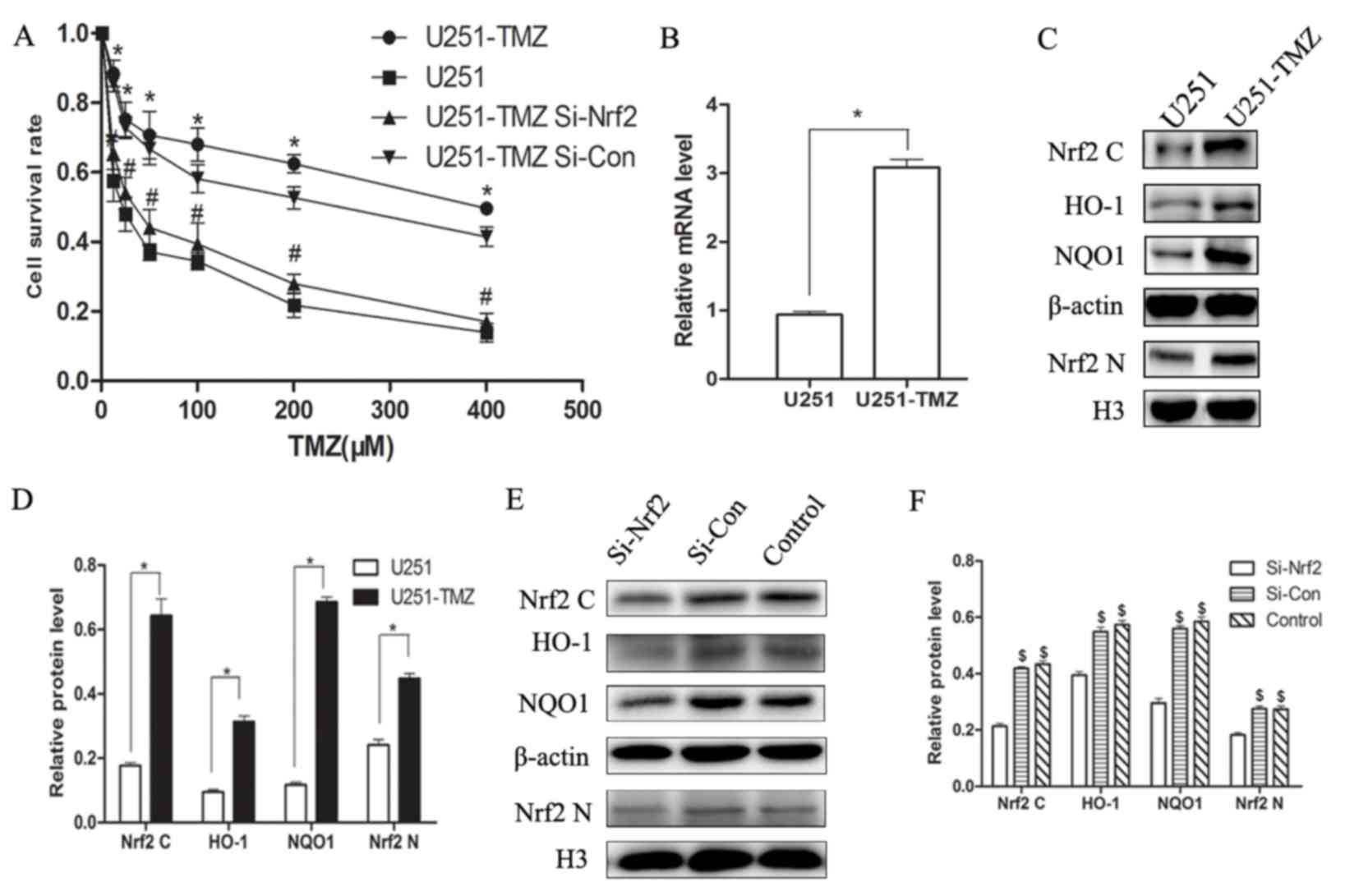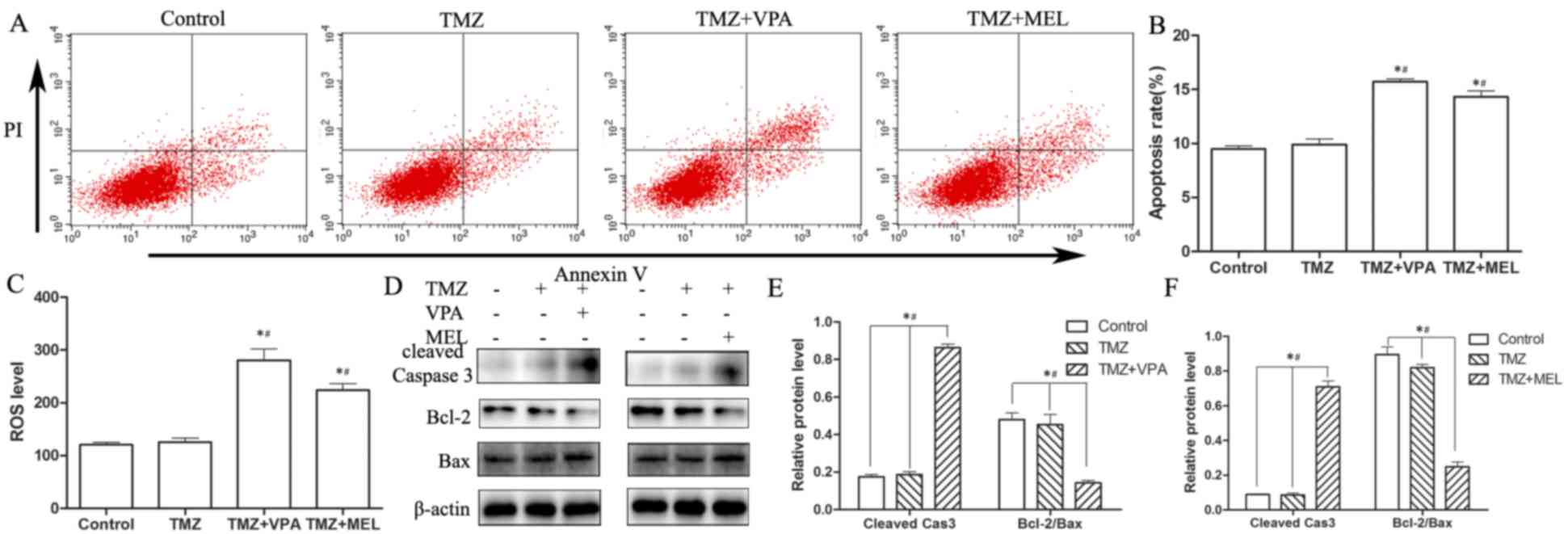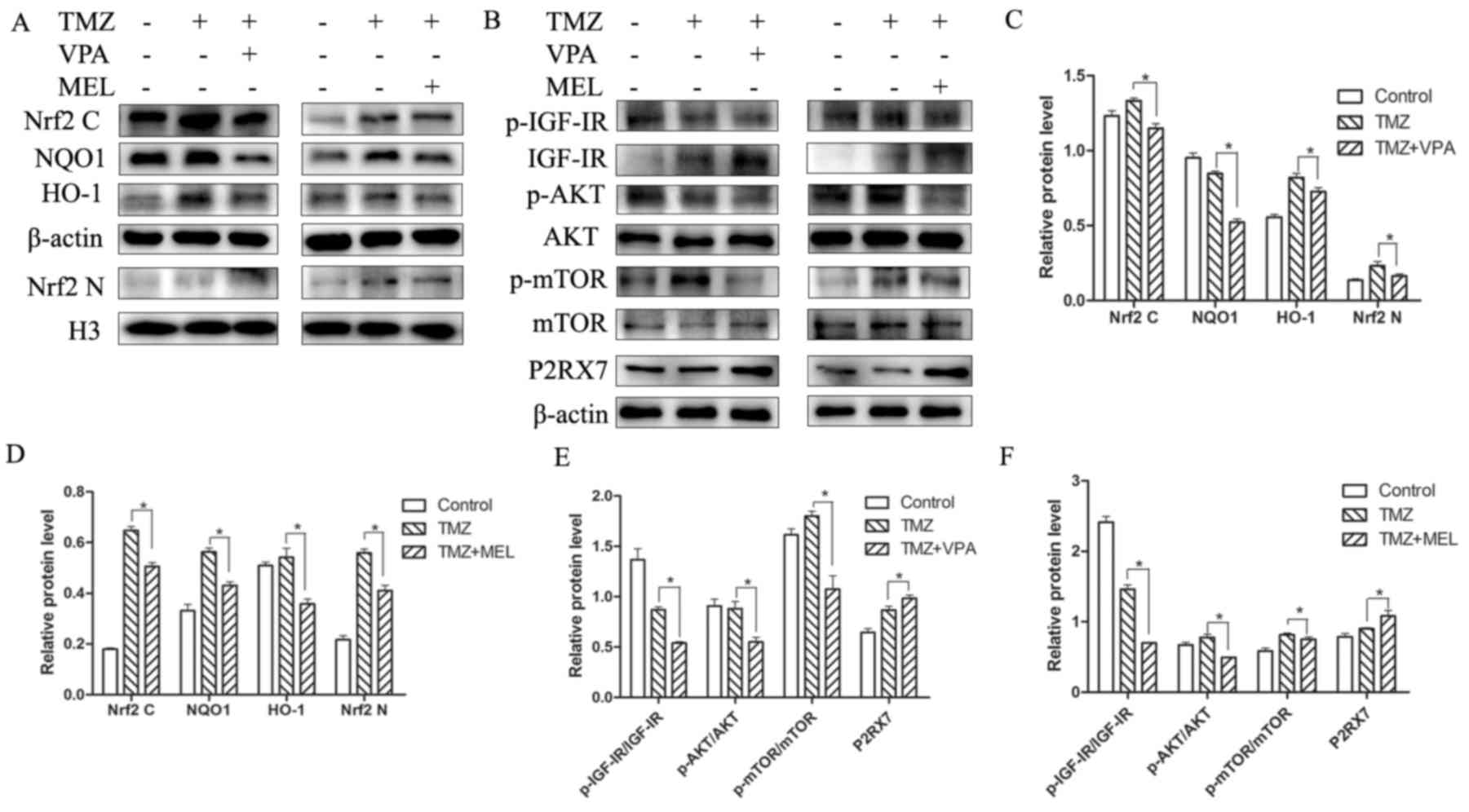|
1
|
Schneider T, Mawrin C, Scherlach C, Skalej
M and Firsching R: Gliomas in adults. Dtsch Arztebl Int.
107:799–808. 2010.PubMed/NCBI
|
|
2
|
Ohgaki H and Kleihues P: Population-based
studies on incidence, survival rates, and genetic alterations in
astrocytic and oligodendroglial gliomas. J Neuropathol Exp. Neurol.
64:479–489. 2005.
|
|
3
|
DeAngelis LM: Brain tumors. N Engl J Med.
344:114–123. 2001. View Article : Google Scholar : PubMed/NCBI
|
|
4
|
Pan H, Wang H, Zhu L, Mao L, Qiao L and Su
X: The role of Nrf2 in migration and invasion of human glioma cell
U251. World Neurosurg. 80:363–370. 2013. View Article : Google Scholar : PubMed/NCBI
|
|
5
|
Ji XJ, Chen SH, Zhu L, Pan H, Zhou Y, Li
W, You WC, Gao CC, Zhu JH, Jiang K and Wang HD: Knockdown of
NF-E2-related factor 2 inhibits the proliferation and growth of
U251MG human glioma cells in a mouse xenograft model. Oncol Rep.
30:157–164. 2013.PubMed/NCBI
|
|
6
|
Pan H, Wang H, Zhu L, Wang X, Cong Z, Sun
K and Fan Y: The involvement of Nrf2-ARE pathway in regulation of
apoptosis in human glioblastoma cell U251. Neurol Res. 35:71–78.
2013. View Article : Google Scholar : PubMed/NCBI
|
|
7
|
Zhou Y, Wang HD, Zhu L, Cong ZX, Li N, Ji
XJ, Pan H, Wang JW and Li WC: Knockdown of Nrf2 enhances autophagy
induced by temozolomide in U251 human glioma cell line. Oncol Rep.
29:394–400. 2013.PubMed/NCBI
|
|
8
|
Ji X, Wang H, Zhu J, Zhu L, Pan H, Li W,
Zhou Y, Cong Z, Yan F and Chen S: Knockdown of Nrf2 suppresses
glioblastoma angiogenesis by inhibiting hypoxia-induced activation
of HIF-1α. Int J Cancer. 135:574–584. 2014. View Article : Google Scholar : PubMed/NCBI
|
|
9
|
Gao AM, Ke ZP, Shi F, Sun GC and Chen H:
Chrysin enhances sensitivity of BEL-7402/ADM cells to doxorubicin
by suppressing PI3K/Akt/Nrf2 and ERK/Nrf2 pathway. Chem Biol
Interact. 206:100–108. 2013. View Article : Google Scholar : PubMed/NCBI
|
|
10
|
Livak KJ and Schmittgen TD: Analysis of
relative gene expression data using real-time quantitative PCR and
the 2(−Delta Delta C(T)) Method. Methods. 25:402–408. 2001.
View Article : Google Scholar : PubMed/NCBI
|
|
11
|
Gong Y, Ni ZH, Zhang X, Chen XH and Zou
ZM: Valproic Acid Enhances the Anti-Tumor Effect of (−)-gossypol to
Burkitt Lymphoma Namalwa Cells. Biomed Environ Sci. 28:773–777.
2015.PubMed/NCBI
|
|
12
|
Fushida S, Kaji M, Oyama K, Hirono Y,
Nezuka H, Takeda T, Tsukada T, Fujimoto D, Ohyama S, Fujimura T and
Ohta T: Randomized Phase II trial of paclitaxel plus valproic acid
vs paclitaxel alone as second-line therapy for patients with
advanced gastric cancer. Onco Targets Ther. 8:939–941. 2015.
View Article : Google Scholar : PubMed/NCBI
|
|
13
|
Sookprasert A, Johns NP, Phunmanee A,
Pongthai P, Cheawchanwattana A, Johns J, Konsil J, Plaimee P,
Porasuphatana S and Jitpimolmard S: Melatonin in patients with
cancer receiving chemotherapy: A randomized, double-blind,
placebo-controlled trial. Anticancer Res. 34:7327–7337.
2014.PubMed/NCBI
|
|
14
|
Fan L, Sun G, Ma T, Zhong F and Wei W:
Melatonin overcomes apoptosis resistance in human hepatocellular
carcinoma by targeting survivin and XIAP. J Pineal Res. 55:174–183.
2013. View Article : Google Scholar : PubMed/NCBI
|
|
15
|
Thotala D, Karvas RM, Engelbach JA, Garbow
JR, Hallahan AN, DeWees TA, Laszlo A and Hallahan DE: Valproic acid
enhances the efficacy of radiation therapy by protecting normal
hippocampal neurons and sensitizing malignant glioblastoma cells.
Oncotarget. 6:35004–35022. 2015.PubMed/NCBI
|
|
16
|
Yuan Y, Xiang W, Qing M, Yanhui L, Jiewen
L and Yunhe M: Survival analysis for valproic acid use in adult
glioblastoma multiforme: A meta-analysis of individual patient data
and a systematic review. Seizure. 23:830–835. 2014. View Article : Google Scholar : PubMed/NCBI
|
|
17
|
Martín V, Sanchez-Sanchez AM, Herrera F,
Gomez-Manzano C, Fueyo J, Alvarez-Vega MA, Antolín I and Rodriguez
C: Melatonin-induced methylation of the ABCG2/BCRP promoter as a
novel mechanism to overcome multidrug resistance in brain tumour
stem cells. Br J Cancer. 108:2005–2012. 2013. View Article : Google Scholar : PubMed/NCBI
|
|
18
|
Cullinan SB, Gordan JD, Jin J, Harper JW
and Diehl JA: The Keap1-BTB protein is an adaptor that bridges Nrf2
to a Cul3-based E3 ligase: Oxidative stress sensing by a Cul3-Keap1
ligase. Mol Cell Biol. 24:8477–8486. 2004. View Article : Google Scholar : PubMed/NCBI
|
|
19
|
Lau A, Villeneuve NF, Sun Z, Wong PK and
Zhang DD: Dual roles of Nrf2 in cancer. Pharmacol Res. 58:262–270.
2008. View Article : Google Scholar : PubMed/NCBI
|
|
20
|
Jiang T, Chen N, Zhao F, Wang XJ, Kong B,
Zheng W and Zhang DD: High levels of Nrf2 determine chemoresistance
in type II endometrial cancer. Cancer Res. 70:5486–5496. 2010.
View Article : Google Scholar : PubMed/NCBI
|
|
21
|
Hu L, Miao W, Loignon M, Kandouz M and
Batist G: Putative chemopreventive molecules can increase
Nrf2-regulated cell defense in some human cancer cell lines,
resulting in resistance to common cytotoxic therapies. Cancer
Chemother Pharmacol. 66:467–474. 2010. View Article : Google Scholar : PubMed/NCBI
|
|
22
|
Wang XJ, Sun Z, Villeneuve NF, Zhang S,
Zhao F, Li Y, Chen W, Yi X, Zheng W, Wondrak GT, et al: Nrf2
enhances resistance of cancer cells to chemotherapeutic drugs, the
dark side of Nrf2. Carcinogenesis. 29:1235–1243. 2008. View Article : Google Scholar : PubMed/NCBI
|
|
23
|
Singh A, Boldin-Adamsky S, Thimmulappa RK,
Rath SK, Ashush H, Coulter J, Blackford A, Goodman SN, Bunz F,
Watson WH, et al: RNAi-mediated silencing of nuclear factor
erythroid-2-related factor 2 gene expression in non-small cell lung
cancer inhibits tumor growth and increases efficacy of
chemotherapy. Cancer Res. 68:7975–7984. 2008. View Article : Google Scholar : PubMed/NCBI
|
|
24
|
Kuroda H, Takeno M, Murakami S, Miyazawa
N, Kaneko T and Ishigatsubo Y: Inhibition of heme oxygenase-1 with
an epidermal growth factor receptor inhibitor and cisplatin
decreases proliferation of lung cancer A549 cells. Lung Cancer.
67:31–36. 2010. View Article : Google Scholar : PubMed/NCBI
|
|
25
|
Rushworth SA, Bowles KM, Raninga P and
MacEwan DJ: NF-kappaB-inhibited acute myeloid leukemia cells are
rescued from apoptosis by heme oxygenase-1 induction. Cancer Res.
70:2973–2983. 2010. View Article : Google Scholar : PubMed/NCBI
|
|
26
|
Kim YS, Zerin T and Song HY: Antioxidant
action of ellagic acid ameliorates paraquat-induced A549
cytotoxicity. Biol Pharm Bull. 36:609–615. 2013. View Article : Google Scholar : PubMed/NCBI
|
|
27
|
Ryu CH, Yoon WS, Park KY, Kim SM, Lim JY,
Woo JS, Jeong CH, Hou Y and Jeun SS: Valproic acid downregulates
the expression of MGMT and sensitizes temozolomide-resistant glioma
cells. J Biomed Biotechnol. 2012:9874952012. View Article : Google Scholar : PubMed/NCBI
|
|
28
|
Chen Y, Tsai YH and Tseng SH: Valproic
acid affected the survival and invasiveness of human glioma cells
through diverse mechanisms. J Neurooncol. 109:23–33. 2012.
View Article : Google Scholar : PubMed/NCBI
|
|
29
|
Chen CH, Chang YJ, Ku MS, Chung KT and
Yang JT: Enhancement of temozolomide-induced apoptosis by valproic
acid in human glioma cell lines through redox regulation. J Mol Med
(Berl). 89:303–315. 2011. View Article : Google Scholar : PubMed/NCBI
|
|
30
|
Srinivasan V, Spence DW, Pandi-Perumal SR,
Trakht I and Cardinali DP: Therapeutic actions of melatonin in
cancer: Possible mechanisms. Integr Cancer Ther. 7:189–203. 2008.
View Article : Google Scholar : PubMed/NCBI
|
|
31
|
Martín V, Herrera F, Carrera-Gonzalez P,
García-Santos G, Antolín I, Rodriguez-Blanco J and Rodriguez C:
Intracellular signaling pathways involved in the cell growth
inhibition of glioma cells by melatonin. Cancer Res. 66:1081–1088.
2006. View Article : Google Scholar : PubMed/NCBI
|
|
32
|
González A, Martinez-Campa C, Mediavilla
MD, Alonso-González C, Sánchez-Barceló EJ and Cos S: Inhibitory
effects of pharmacological doses of melatonin on aromatase activity
and expression in rat glioma cells. Br J Cancer. 97:755–760. 2007.
View Article : Google Scholar : PubMed/NCBI
|
|
33
|
Martín V, Herrera F, García-Santos G,
Antolín I, Rodriguez-Blanco J, Medina M and Rodriguez C:
Involvement of protein kinase C in melatonin's oncostatic effect in
C6 glioma cells. J Pineal Res. 43:239–244. 2007. View Article : Google Scholar : PubMed/NCBI
|
|
34
|
Martín V, García-Santos G,
Rodriguez-Blanco J, Casado-Zapico S, Sanchez-Sanchez A, Antolín I,
Medina M and Rodriguez C: Melatonin sensitizes human malignant
glioma cells against TRAIL-induced cell death. Cancer Lett.
287:216–223. 2010. View Article : Google Scholar : PubMed/NCBI
|
|
35
|
Martín V, Sanchez-Sanchez AM, Herrera F,
Gomez-Manzano C, Fueyo J, Alvarez-Vega MA, Antolín I and Rodriguez
C: Melatonin-induced methylation of the ABCG2/BCRP promoter as a
novel mechanism to overcome multidrug resistance in brain tumour
stem cells. Br J Cancer. 108:2005–2012. 2013. View Article : Google Scholar : PubMed/NCBI
|
|
36
|
Jumnongprakhon P, Govitrapong P, Tocharus
C, Pinkaew D and Tocharus J: Melatonin protects
methamphetamine-induced neuroinflammation through NF-κB and Nrf2
pathways in glioma cell line. Neurochem Res. 40:1448–1456. 2015.
View Article : Google Scholar : PubMed/NCBI
|
|
37
|
Ding K, Wang H, Xu J, Li T, Zhang L, Ding
Y, Zhu L, He J and Zhou M: Melatonin stimulates antioxidant enzymes
and reduces oxidative stress in experimental traumatic brain
injury: The Nrf2-ARE signaling pathway as a potential mechanism.
Free Radic Biol Med. 73:1–11. 2014. View Article : Google Scholar : PubMed/NCBI
|
|
38
|
Negi G, Kumar A and Sharma SS: Melatonin
modulates neuroinflammation and oxidative stress in experimental
diabetic neuropathy: Effects on NF-κB and Nrf2 cascades. J Pineal
Res. 50:124–131. 2011.PubMed/NCBI
|
|
39
|
Lee YJ, Jeong HY, Kim YB, Lee YJ, Won SY,
Shim JH, Cho MK, Nam HS and Lee SH: Reactive oxygen species and
PI3K/Akt signaling play key roles in the induction of Nrf2-driven
heme oxygenase-1 expression in sulforaphane-treated human
mesothelioma MSTO-211H cells. Food Chem Toxicol. 50:116–123. 2012.
View Article : Google Scholar : PubMed/NCBI
|
|
40
|
Tobón-Velasco JC, Vázquez-Victorio G,
Macías-Silva M, Cuevas E, Ali SF, Maldonado PD, González-Trujano
ME, Cuadrado A, Pedraza-Chaverrí J and Santamaría A: RETRACTED:
S-allyl cysteine protects against 6-hydroxydopamine-induced
neurotoxicity in the rat striatum: Involvement of Nrf2
transcription factor activation and modulation of signaling kinase
cascades. Free Radic Biol Med. 53:1024–1040. 2012. View Article : Google Scholar : PubMed/NCBI
|
|
41
|
Hsu YY, Tseng YT and Lo YC: Berberine, a
natural antidiabetes drug, attenuates glucose neurotoxicity and
promotes Nrf2-related neurite outgrowth. Toxicol Appl Pharmacol.
272:787–796. 2013. View Article : Google Scholar : PubMed/NCBI
|
|
42
|
Rao J, Qian X, Li G, Pan X, Zhang C, Zhang
F, Zhai Y, Wang X and Lu L: ATF3-mediated NRF2/HO-1 signaling
regulates TLR4 innate immune responses in mouse liver
ischemia/reperfusion injury. Am J Transplant. 15:76–87. 2015.
View Article : Google Scholar : PubMed/NCBI
|


















